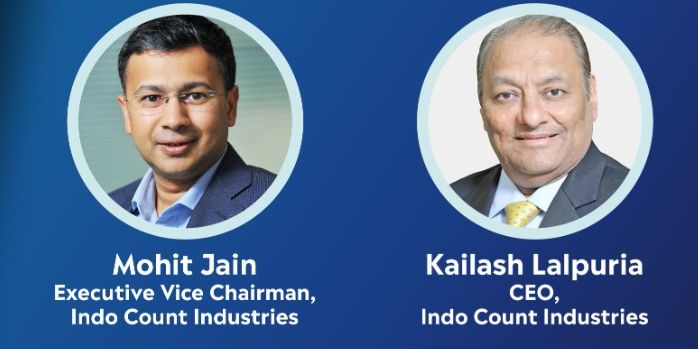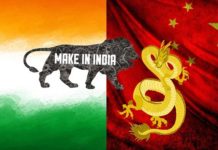https://www.freepressjournal.in/business/fpj-sies-webinar-indo-count-will-look-at-increasing-market-share-globally-also-building-domestic-market
India’s textiles industry is reviving smartly, say Indo Count’s directors
The textile industry in India is optimistic that good times will continue for a long time if supported by long-term favourable policies. This will not just help these textile companies to grow but enjoy a good global market share.
In the webinar ‘Vision for the Textile Industry’ organised by the Free Press Journal and SIES, Mohit Jain, Executive Vice Chairman, Indo Count Industries and the company’s Chief Executive Officer Kailash Lalpuria shared the journey of the firm. In addition, the two top executives of Indo Count spoke about the aspirations of the industry during the chat with R N Bhaskar, Consulting Editor of FPJ.
Journey…
Mohit Jain, Promotor and Executive Vice Chairman of Indo Count: We are a home textile company. We manufacture all the textiles that go on the bed other than the mattress. The company manufactures 250 kms of bed linen every single day that is around 90 million metres per year. By the end of the year, we will increase it by another 20 per cent. One in every eight bed sheets sold in the United States is by Indo Count. We have an annual surplus of USD 350 million and growing.
We are a Mumbai-headquartered global company with manufacturing facilities based in Kolhapur. Indo Count ships to over six continents and is present in 54 countries around the world. The United States is the largest market, 75 per cent of the company’s revenue comes from there.
Our customers are retailers like Walmart, Target, Macy’s, Bed Bath & Beyond, Asda, Primark, and many others. We ship to them. We are an integrated company and the largest bedding exporter in India. The company has almost zero long-term debt on its balance sheet.
The textile industry is extremely important for the country. Around 5 per cent of the GDP comes from this industry, and 17 per cent of India’s export. It is estimated that the textile industry employs around 45 million people. For the last three years, India has been the largest grower of cotton in the world.
Our customers are mainly retailers today. In that sense, we are a B2B (business to business) company. In the next five-ten years to come, we are looking at B2C (business to customer) and D2C (direct to consumer through a portal). So, to achieve this we have launched two brands namely Boutique Living and Layers in India.
Indo Count has announced a new partnership with a licensed brand, Jasper Conran, for a bed and bath collection, which will be launched in Spring 2022.
We have set a target of USD 100 million revenue by 2025 through e-commerce. Of that, 75 per cent will come from the United States, 15 per cent from India and 10 per cent from the United Kingdom. Today, we have over 1,250 SKUs (stock-keeping units).
Textile industry then versus now
Kailash Lalpuria, Executive Director and CEO of Indo Count Industries: Before 2005, India did not meet the expectations of the global supply chain in terms of quality and technology. After the abolition of the textile quota (imposed by the government) in 2005, there was a huge opportunity to ship goods globally. This opportunity was taken up by entrepreneurs. They established world-class facilities with state of the art machinery. A lot of effort was placed to establish India in the global supply chain by running front-end marketing, setting up distribution, branding etc.
Earlier, there was a stigma that India cannot meet global standards as it was a traditional industry meeting domestic demand. But that is not the case now.
In the last decade, India’s textile industry has done remarkably well — as a country, we grabbed 60 per cent market share in bed linen alone and 40-45 per cent in towels. The textile industry is rooted in Indian culture. It was India that moved to value addition along with exporting raw material.
India has got a very good future in the textile industry in the coming years. India is very well-positioned in the coming years as far as raw material is concerned.
Countries like Bangladesh and Vietnam do not have a large domestic market. This is where India comes into the picture as it has a large domestic market, like China.
Diversification
Mohit Jain: There will be a time when you want the best economies of scale within a particular area. So that we can have the best of the infrastructure and other resources we have. As an organisation, we are not averse to going into other states or any other locations within Maharashtra. We keep evaluating our options on a monthly basis. This is to understand where the organisation needs to invest as we move forward. This is part of growing up and we will make the decision as and when required.
We will continue to have our core business in India even though we supply to the global market. This is because we are not just working on our own strengths but also on our country’s strengths.
Kailash Lalpuria: Over the last 30 years, Indo Count has built a culture of export. We have built a competitive edge in India. In addition, India is well-positioned in case of raw materials and competitiveness. Thus, it makes sense to continue in India. If need be, we may start facilities in other regions based on the needs of the customer.
India has proved its competitiveness in the global market. About 85 per cent of the textile is supplied by five Asian countries in the world — China, India, Pakistan, Bangladesh and Vietnam. Bangladesh and Vietnam work on their labour strength. They do not have the raw materials. China, India and Pakistan have the raw material. In the case of China, it is slowing down. This is mainly because of the China-plus-one strategy impacting their business. Meanwhile, Pakistan has got limited raw material supply but has a strong textile industry.
Position of the garment industry in India
Mohit Jain: There is a two-pronged approach here. Unfortunately, the garment industry in our country is pretty fragmented. Entrepreneurs have cut and sew facilities. However, they have never invested backwards in infrastructure. Due to many factors prevailing in the country, the garment players are left with very slim margins. This is why entrepreneurs have moved to Cambodia, Vietnam, Bangladesh etc as the labour is cheaper. In addition, Bangladesh has a duty advantage in Europe.
Now going to the home textile business. It started building itself after the 2005 quota was abolished. The home textile companies started from scratch. They decided to do the complete value chain. We take a finished product to customers and tell them these are the products that we can offer at a price that works for both. In India, we have the strength of growing our own cotton. In addition, the duty structure in India is at a reasonable level. So, there is no need to go to another country.
At the same time, we are evaluating the possibility of having a cut and sew facility in the United States — as the e-commerce industry grows it makes sense to be close to the market. In addition, this is a non-polluting facility, and that makes it affordable to set it up in the US. So, if it makes sense to set up such a facility in the US, we will invest.
Kailash Lalpuria: About 70 per cent of global textile trading is done in man-made fibre and only 30 per cent in natural fibre. India is missing that 70 per cent market as it is largely apparel that is tilted towards man-made fabric (MMF). India is expensive in the case of man-made fibre. This is because India is yet to reduce the tax rate in man-made and rationalise it for mass production of MMF. India has not invested in the downstream of the man-made fibre industry as well. All these factors have deprived India of gaining market share in the overall textile industry.
Of late, the government understands this. That is why the government is looking at a simplified tax structure for the textile industry. India is well equipped with a man-made fibre supply chain. And it should do well in the coming decade.
Cotton versus man-made fibre
Kailash Lalpuria: Cotton is connected to farmers and India is a pro-farmer nation. So, you need to protect them. These farmers are impacted by climate changes, changing prices etc. and this, in turn, impacts the cotton supply chain. The government has to consider all the volatility and provide flexibility in order to maintain the supply chain.
There is never an intention to keep polyester prices higher and cotton cheaper. It needs to be noted that cotton is a sustainable fibre that will continue to do well in the coming future. Meanwhile, the government is trying to simplify the duty structure of the man-made fabric. In India, we are at the commodity stage and not much value addition has taken place in man-made fibre. The government recognises the problem. Thus, it is working out a structure under the PLI scheme by including textile in the priority sector.
Rural market demand
Kailash Lalpuria: India aspires to become a USD-5-trillion economy. Today, textile is around USD 150 billion in the USD-2.5-trillion Indian economy or say it contributes 4-5 per cent to the GDP. When India aims to achieve the five-trillion-dollar mark, the textile industry will also have to scale up. That means textile will be a USD 300 billion industry and export will be USD 100 billion, and the domestic market will be valued at USD 200 billion. When India is growing at this speed, the contribution of rural India will be vital. Due to electrification, smart city projects, digitalisation etc, rural India will contribute a fair share to the Indian economy.
Vision
Mohit Jain: In the next three to five years, Indo Count will look at increasing the market share globally. This will not be limited to our main market but across the world.
In the next 5-10 years, we are looking at establishing our brand in the domestic market — India. Every product we sell in the domestic market is specifically designed for the domestic market and it is not a surplus or export reject product. Our vision is to remain in the home textile business and to grow the businesses — be focused and capture the market share by spreading across the world.
Government support
Kailash Lalpuria: The government today understands the contribution of the textile industry. Thus, the government extended the Rebate of State and Central Taxes and Levies (RoSCTL) scheme for the next three years. This will bring in stability and predictability. In addition, after signing a free trade agreement with Australia, the EU, Canada, and UK, India has the right ingredients to grow.
The stage is set for growth. However, some support from the regulator and the government will be needed to give the textile industry a boost. India will play a major role in the textile space.








































COMMENTS